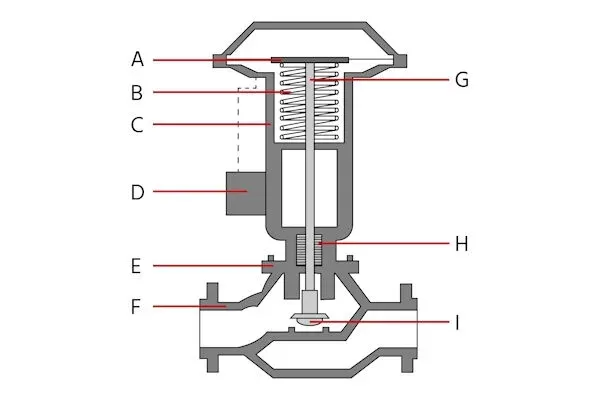Notifications

7 minutes, 59 seconds
-163 Views 0 Comments 0 Likes 0 Reviews

Understanding Pneumatic Control Valves: Components, Common Faults, and Troubleshooting
Pneumatic control valves are essential in a wide range of industrial applications, providing precise regulation of fluid and gas flow by converting air pressure into mechanical motion. These China Control Valves are especially vital in systems that demand automation, accuracy, and reliable flow management. A solid grasp of how pneumatic control valves function, the issues they commonly face, and how to troubleshoot them is key to maintaining system efficiency and minimizing downtime.
A pneumatic control valve comprises several integral components, each designed to ensure accurate, smooth operation. Here’s a breakdown of the main parts and their functions:
The actuator converts air pressure into mechanical movement, driving the valve stem to control flow. There are two main types:
Diaphragm Actuators: Ideal for low-pressure applications, these actuators use a flexible diaphragm that responds quickly to air pressure changes.
Piston Actuators: Built for high-pressure environments, these use a piston mechanism, offering greater durability and force.
Actuators are further classified as:
Single-Acting: Air pressure moves the actuator in one direction; a spring returns it when pressure is lost.
Double-Acting: Air pressure is used for motion in both directions, providing more precise control.
In single-acting actuators, the spring acts as a fail-safe, returning the valve to a safe default position in the event of air supply failure. This is crucial for process safety and continuity.
The yoke is a structural link that connects the actuator to the valve body. It ensures proper alignment and supports the assembly, especially in high-pressure or high-vibration environments.
The positioner ensures accurate valve positioning by receiving control signals and adjusting the actuator accordingly. It also provides feedback to the control system. Types include:
Pneumatic Positioners: Operate using air signals.
Electro-Pneumatic Positioners: Translate electrical signals into pneumatic control.
Digital Positioners: Offer high-precision control with real-time feedback and advanced communication features.
The bonnet encloses the valve stem and internal components, providing a pressure-sealed environment and access for maintenance. It must withstand operational pressures and temperatures.
The valve body houses key flow-regulating elements such as the seat and plug. Different body types offer various control characteristics:
Globe Valves: Excellent for throttling.
Ball Valves: Fast operation with minimal pressure drop.
Butterfly Valves: Best for large-volume, low-pressure systems.
Gate Valves: Primarily used for on/off control.
This component transmits motion from the actuator to the plug or disc. It must resist torque, vibration, and wear while maintaining a leak-tight seal.
These components prevent leakage throughout the valve assembly. Over time, they wear out and must be routinely inspected and replaced to maintain efficiency and safety.
The seat and plug work together to regulate flow. The plug’s movement into or out of the seat opens or closes the valve. Material selection and machining precision are vital for sealing performance and longevity.
Despite their robust construction, pneumatic control valves can encounter various issues that affect performance. Recognizing these faults early is key to avoiding disruptions:
Leaks in the air supply system can reduce actuator force, leading to sluggish or unresponsive valve movement. Causes may include worn seals, loose connections, or damaged tubing.
Internal corrosion, debris, or rust can hinder valve stem movement. This impairs valve responsiveness and can impact system efficiency.
Actuators can fail due to wear, inadequate air pressure, or mechanical damage, causing the valve to get stuck or respond inconsistently.
Miscalibrated or faulty positioners can result in inaccurate valve positioning, disrupting flow regulation. Issues may stem from electrical faults, signal distortion, or air supply inconsistencies.
Worn or damaged seals can lead to fluid or air leaks, reducing system pressure and efficiency, and potentially creating safety hazards.
An organized troubleshooting approach helps identify root causes efficiently and restores functionality. Follow these steps:
Analyze past maintenance records to spot recurring issues or trends that could help diagnose the current problem.
Look for physical damage, corrosion, wear, or leaks in and around the valve, actuator, and connected components.
Use a pressure gauge to confirm that the air supply is stable and within operating specifications. Inspect for leaks, blockages, or pressure drops.
Check for proper actuator movement and listen for hissing sounds that indicate air leaks. Confirm it’s receiving adequate air pressure and control input.
Ensure the positioner is correctly calibrated according to the manufacturer’s instructions. Inspect for signal errors and physical or electronic faults.
Verify that control signals from the process control system are accurate and consistent. Inspect wiring and connectors for faults or interference.
Manually operate the valve to assess smoothness and response. Any grinding or resistance could suggest internal damage or obstructions.
If necessary, disassemble the valve to check the condition of the stem, seat, plug, seals, and gaskets. Clean out debris and replace worn components.
Ensure the connected pipeline is free of blockages, buildup, or corrosion that could restrict flow and affect valve operation.
Pneumatic control valves are a cornerstone of industrial automation, offering precise and dependable control of fluid and gas flow. While durable, these valves can develop issues that disrupt performance. A thorough understanding of their components, potential faults, and systematic troubleshooting ensures optimal function and minimal downtime. By prioritizing routine inspections and proactive maintenance, industries can keep their pneumatic systems operating at peak performance.Know more about Google SEO Directory

